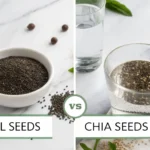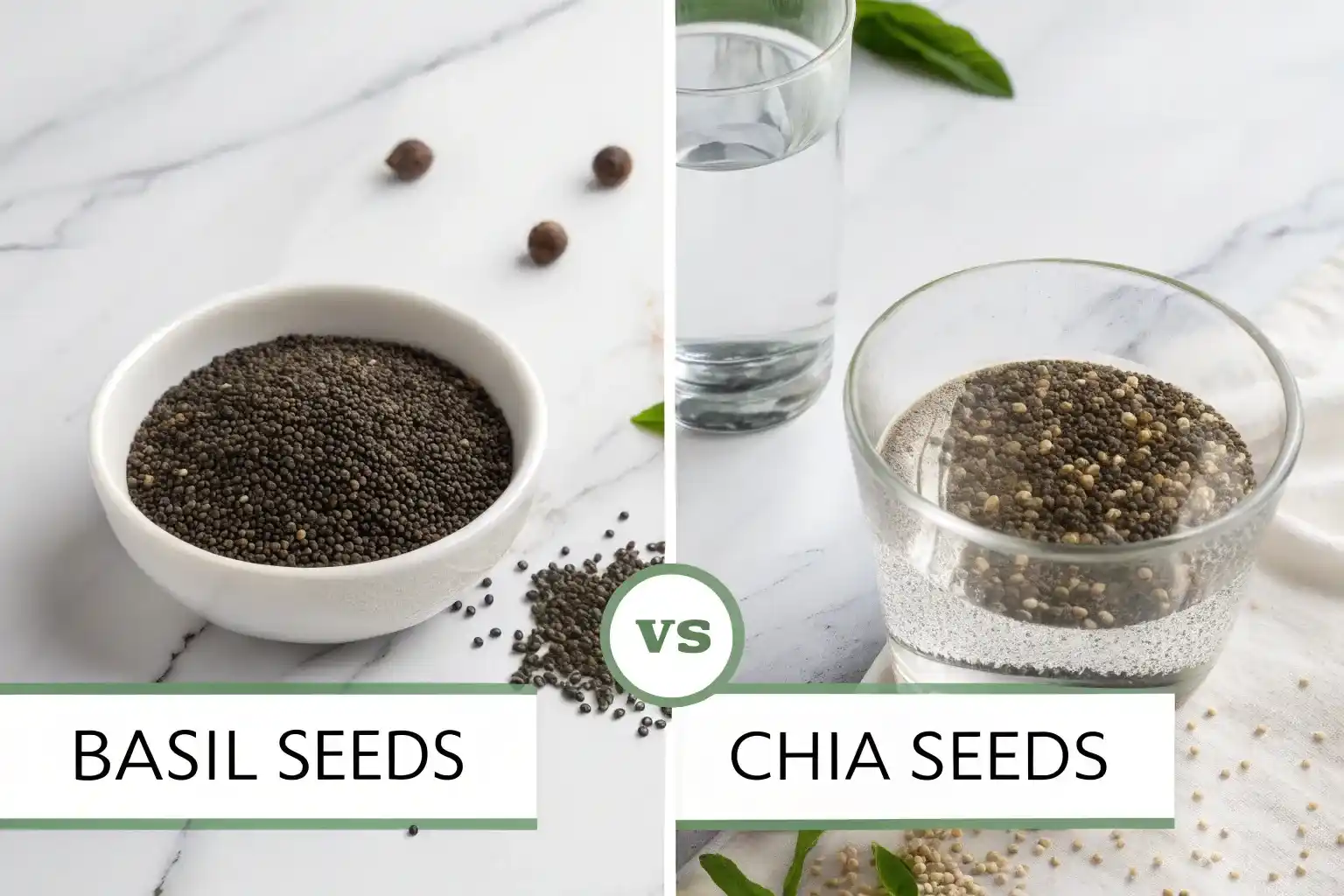The Rise of Superfood Seeds
The health and wellness world has embraced tiny seeds as nutritional powerhouses, with basil seeds and chia seeds leading the charge as must-have ingredients for smoothies, puddings, and healthy snacks. Both seeds have earned their superfood status through impressive nutrient profiles and unique culinary properties that transform simple recipes into satisfying, health-boosting meals.
But with two seemingly similar options available, many health-conscious individuals find themselves wondering which seed deserves a permanent spot in their pantry. This comprehensive comparison will examine basil seeds vs chia seeds across appearance, nutrition, usage, and benefits to help you make an informed decision about which superfood seed aligns best with your health goals and culinary preferences.
What Are Basil Seeds?
Basil seeds, scientifically known as Ocimum basilicum seeds and commonly called sabja seeds or tukmaria, come from the sweet basil plant that many of us grow in our herb gardens. These tiny, black, teardrop-shaped seeds have been used in traditional Ayurvedic medicine for centuries, particularly in India and Southeast Asia.
The most remarkable characteristic of basil seeds is their incredible ability to absorb liquid and transform almost instantly. When exposed to water or any liquid, they develop a translucent, gelatinous coating within just 2-3 minutes, expanding to nearly three times their original size. This unique property creates a satisfying, almost tapioca-like texture that makes them perfect for puddings and drinks.
Their ability to gel makes them the perfect ingredient for my healthy Basil Seed Pudding, where they create an incredibly creamy, satisfying texture that rivals traditional dairy-based desserts.
What Are Chia Seeds?
Chia seeds come from the Salvia hispanica plant, a member of the mint family native to Mexico and Guatemala. These small, oval-shaped seeds display a beautiful mottled pattern in shades of grey, black, white, and brown, making them instantly recognizable to anyone familiar with superfood ingredients.
Like basil seeds, chia seeds possess the remarkable ability to absorb liquid and form a gel-like consistency. However, chia seeds typically require 15-20 minutes to fully hydrate and reach their maximum expansion. When properly soaked, they develop a less pronounced gel coating compared to basil seeds, creating a texture that many describe as similar to tapioca pearls but with a slightly firmer bite.
The versatility of chia seeds extends beyond their gel-forming properties. Unlike basil seeds, chia seeds can be consumed raw, making them excellent additions to salads, yogurt, or smoothie bowls where you want added nutrition without changing the base texture.
Head-to-Head Comparison: Nutrition, Use, and Taste
| Aspect | Basil Seeds (1 tbsp) | Chia Seeds (1 tbsp) |
|---|---|---|
| Calories | 15-20 | 60 |
| Fiber | 7g | 5g |
| Protein | 1g | 3g |
| Omega-3s | Moderate | High |
| Soak Time | 2-3 minutes | 15-20 minutes |
| Texture When Soaked | Very gelatinous, translucent coating | Mild gel, firmer texture |
| Taste | Subtle basil flavor | Virtually tasteless |
| Raw Consumption | Must be soaked first | Can eat dry or soaked |
| Best Uses | Puddings, drinks, weight loss | Puddings, baking, egg substitute |
The nutritional comparison reveals interesting differences between these superfood seeds. Basil seeds edge out chia seeds in fiber content while containing significantly fewer calories, making them particularly appealing for those focused on basil seeds for weight loss goals. The high fiber content in both seeds promotes feelings of fullness and supports digestive health.
Chia seeds contain more protein and omega-3 fatty acids, making them particularly valuable for plant-based diets where these nutrients can be harder to obtain. The omega-3 content in chia seeds rivals that found in flaxseeds, supporting heart and brain health.
Key Differences in How to Use Them
The most crucial difference between basil seeds vs chia seeds lies in their preparation requirements and culinary applications. Basil seeds must always be soaked before consumption, as eating them dry can be unpleasant and potentially unsafe. Their rapid hydration makes them perfect for quick recipes where you want immediate results.
Chia seeds offer more versatility since they can be enjoyed both dry and soaked. Sprinkle them raw over salads, blend them into smoothies for added nutrition, or soak them for puddings and breakfast bowls. This flexibility makes chia seeds more convenient for busy lifestyles where meal prep time is limited.
When it comes to texture preferences, basil seeds create an intensely gelatinous, almost jelly-like consistency that some find more satisfying for puddings and drinks. Chia seeds produce a milder gel with individual seeds that maintain more of their original texture, appealing to those who prefer subtle textural variety in their foods.
For substitute for chia seeds applications, basil seeds work excellently in most pudding and beverage recipes, though you may need to adjust liquid ratios due to their superior absorption capacity.
Which One Should You Choose?
For puddings and drinks: Both seeds excel in these applications, though your choice depends on texture preference. If you love an intensely creamy, almost custard-like consistency, basil seeds are your winner. For those who prefer a gentler gel with more textural interest, chia seeds deliver perfectly.
For weight loss goals: Basil seeds for weight loss applications shine due to their higher fiber content and lower calorie count. The rapid expansion and gel formation create immediate satiety, helping control portion sizes and reduce cravings between meals.
As an egg replacer in baking: Chia seeds generally perform better as an egg substitute due to their protein content and binding properties. Mix one tablespoon of chia seeds with three tablespoons of water, let sit for 15 minutes, and use as a replacement for one egg in most recipes.
For topping foods and raw consumption: Chia seeds are the clear winner here since they can be eaten dry. Their mild flavor and pleasant crunch make them perfect for sprinkling over yogurt, oatmeal, or salads without requiring advance preparation.
For traditional wellness practices: If you’re interested in Ayurvedic nutrition or traditional Indian wellness practices, basil seeds offer centuries of documented use for cooling the body, supporting digestion, and promoting overall balance.
Conclusion: The Verdict
Both basil seeds and chia seeds deserve recognition as legitimate superfoods with unique benefits and applications. Rather than viewing this as an either-or decision, consider incorporating both into your nutritional arsenal based on your specific needs and culinary goals.
Basil seeds excel for quick, intensely satisfying puddings and drinks, particularly when weight management is a priority. Their benefits of basil seeds include superior fiber content, rapid preparation, and traditional wellness applications that have stood the test of time.
Chia seeds offer unmatched versatility, higher protein content, and the convenience of raw consumption. Their omega-3 profile and binding properties make them invaluable for plant-based cooking and baking applications.
The beauty of exploring superfood seeds lies in discovering how different ingredients can enhance your health journey in unique ways. Why not try both and experience firsthand how these remarkable seeds can transform your favorite recipes?
Frequently Asked Questions
u003cstrongu003eCan I substitute basil seeds for chia seeds in a recipe?u003c/strongu003e
Yes, you can substitute basil seeds for chia seeds in most pudding and beverage recipes. Use about 25% less basil seeds since they absorb more liquid and expand more dramatically. Keep in mind that basil seeds create a more gelatinous texture and have a subtle basil flavor, so the final result will differ slightly from the original recipe.
u003cstrongu003eDo basil seeds taste like basil?u003c/strongu003e
Basil seeds have a very mild, subtle basil flavor that’s much less pronounced than fresh basil leaves. Most people describe the taste as neutral with just a hint of herbaceous notes. When mixed into puddings or drinks with other flavors, the basil taste becomes virtually undetectable.
u003cstrongu003eWhere can I buy basil seeds?u003c/strongu003e
Basil seeds are available at most health food stores, Indian grocery stores (where they’re called sabja seeds), and online retailers. Look for them in the bulk bins, spice section, or with other superfoods. Make sure to buy food-grade basil seeds specifically labeled for consumption, not garden variety basil seeds intended for planting.

Basil Seed Pudding
A creamy, satisfying pudding made with basil seeds, perfect for a healthy dessert or snack.
- Total Time: 40 minutes
- Yield: 4 servings 1x
Ingredients
- 3 tablespoons basil seeds
- 2 cups almond milk (or any milk of choice)
- 2 tablespoons honey or maple syrup
- 1 teaspoon vanilla extract
- Fresh fruit for topping (optional)
Instructions
- Soak the basil seeds in water for 2-3 minutes until they expand and form a gelatinous coating.
- In a mixing bowl, combine almond milk, honey (or maple syrup), and vanilla extract.
- Add the soaked basil seeds to the mixture and stir well.
- Refrigerate for at least 30 minutes to thicken further.
- Serve chilled and top with fresh fruit if desired.
Notes
Adjust sweetness according to taste. This pudding can be made in advance and stored in the refrigerator for up to 3 days.
- Prep Time: 10 minutes
- Cook Time: 0 minutes
- Category: Dessert
- Method: No-Cook
- Cuisine: Healthy
- Diet: Vegan
Nutrition
- Serving Size: 1 serving
- Calories: 90
- Sugar: 8g
- Sodium: 20mg
- Fat: 3g
- Saturated Fat: 0g
- Unsaturated Fat: 3g
- Trans Fat: 0g
- Carbohydrates: 16g
- Fiber: 7g
- Protein: 1g
- Cholesterol: 0mg
Keywords: basil seeds, pudding, healthy dessert, vegan dessert

